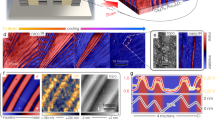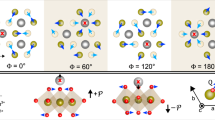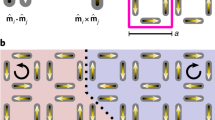Abstract
The coupling between the magnetic and electric dipoles in multiferroic and magnetoelectric materials holds promise for conceptually novel electronic devices1,2,3. This calls for the development of local probes of the magnetoelectric response, which is strongly affected by defects in magnetic and ferroelectric ground states. For example, multiferroic hexagonal rare earth manganites exhibit a dense network of boundaries between six degenerate states of their crystal lattice, which are locked to both ferroelectric and magnetic domain walls. Here we present the application of a magnetoelectric force microscopy technique that combines magnetic force microscopy with in situ modulating high electric fields. This method allows us to image the magnetoelectric response of the domain patterns in hexagonal manganites directly. We find that this response changes sign at each structural domain wall, a result that is corroborated by symmetry analysis and phenomenological modelling4, and provides compelling evidence for a lattice-mediated magnetoelectric coupling. The direct visualization of magnetoelectric domains at mesoscopic scales opens up explorations of emergent phenomena in multifunctional materials with multiple coupled orders.
This is a preview of subscription content, access via your institution
Access options
Subscribe to this journal
Receive 12 print issues and online access
$259.00 per year
only $21.58 per issue
Buy this article
- Purchase on Springer Link
- Instant access to full article PDF
Prices may be subject to local taxes which are calculated during checkout




Similar content being viewed by others
References
Ramesh, R. & Spaldin, N. A. Multiferroics: Progress and prospects in thin films. Nature Mater. 6, 21–29 (2007).
Cheong, S. W. & Mostovoy, M. Multiferroics: A magnetic twist for ferroelectricity. Nature Mater. 6, 13–20 (2007).
Spaldin, N. A., Cheong, S-W. & Ramesh, R. Multiferroics: Past, present, and future. Phys. Today 63, 38–43 (2010).
Das, H., Wysocki, A. L., Geng, Y., Wu, W. & Fennie, C. J. Bulk magnetoelectricity in the hexagonal manganites and ferrites. Preprint at http://arxiv.org/abs/1302.1099 (2013).
Dzyaloshinskii, I. E. On the magneto-electrical effects in antiferromagnets. Zh. Eksp. Teor. Fiz. 37, 881–882 (1959) (English translation in Sov. Phys. JETP 10, 628–629).
Astrov, D. N. The magnetoelectric effect in antiferromagnetics. Zh. Eksp. Teor. Fiz. 38, 984–985 (1960) (English translation in Sov. Phys. JETP 11, 708–709).
Folen, V. J., Rado, G. T. & Stalder, E. W. Anisotropy of the magnetoelectric effect in Cr2O3 . Phys. Rev. Lett. 6, 607–608 (1961).
O’Dell, T. H. The Electrodynamics of Magneto-Electric Media (North-Holland, 1970).
Fiebig, M. Revival of the magnetoelectric effect. J. Phys. D 38, R123–R152 (2005).
Kimura, T. et al. Magnetic control of ferroelectric polarization. Nature 426, 55–58 (2003).
Hur, N. et al. Electric polarization reversal and memory in a multiferroic material induced by magnetic fields. Nature 429, 392–395 (2004).
Essin, A. M., Moore, J. E. & Vanderbilt, D. Magnetoelectric polarizability and axion electrodynamics in crystalline insulators. Phys. Rev. Lett. 102, 146805 (2009).
Qi, X-L. & Zhang, S-C. Topological insulators and superconductors. Rev. Mod. Phys. 83, 1057–1110 (2011).
Borisov, P., Hochstrat, A., Shvartsman, V. V. & Kleemann, W. Superconducting quantum interference device setup for magnetoelectric measurements. Rev. Sci. Instrum. 78, 106105 (2007).
Tokunaga, Y. et al. Composite domain walls in a multiferroic perovskite ferrite. Nature Mater. 8, 558–562 (2009).
Choi, T. et al. Insulating interlocked ferroelectric and structural antiphase domain walls in multiferroic YMnO3 . Nature Mater. 9, 253–258 (2010).
Tokunaga, Y., Taguchi, Y., Arima, T-h. & Tokura, Y. Electric-field-induced generation and reversal of ferromagnetic moment in ferrites. Nature Phys. 8, 838–844 (2012).
Kagawa, F. et al. Dynamics of multiferroic domain wall in spin-cycloidal ferroelectric DyMnO3 . Phys. Rev. Lett. 102, 057604 (2009).
Skumryev, V. et al. Magnetization reversal by electric-field decoupling of magnetic and ferroelectric domain walls in multiferroic-based heterostructures. Phys. Rev. Lett. 106, 057206 (2011).
Geng, Y., Lee, N., Choi, Y. J., Cheong, S-W. & Wu, W. Collective magnetism at multiferroic vortex domain walls. Nano. Lett. 12, 6055–6059 (2012).
Chung, T. K., Carman, G. P. & Mohanchandra, K. P. Reversible magnetic domain-wall motion under an electric field in a magnetoelectric thin film. Appl. Phys. Lett. 92, 112509 (2008).
Katsufuji, T. et al. Dielectric and magnetic anomalies and spin frustration in hexagonal RMnO3 (R = Y, Yb, and Lu). Phys. Rev. B 64, 104419 (2001).
Van Aken, B. B., Palstra, T. T. M., Filippetti, A. & Spaldin, N. A. The origin of ferroelectricity in magnetoelectric YMnO3 . Nature Mater. 3, 164–170 (2004).
Fennie, C. J. & Rabe, K. M. Ferroelectric transition in YMnO3 from first principles. Phys. Rev. B 72, 100103(R) (2005).
Artyukhin, S., Delaney, K. T., Spaldin, N. A. & Mostovoy, M. Landau theory of topological defects in multiferroic hexagonal manganites. Nature Mater. http://dx.doi.org/10.1038/nmat3786 (2013).
Yen, F. et al. Magnetic phase diagrams of multiferroic hexagonal RMnO3 (R = Er, Yb, Tm, and Ho). J. Mater. Res. 22, 2163–2173 (2007).
Chae, S. C. et al. Evolution of the domain topology in a ferroelectric. Phys. Rev. Lett. 110, 167601 (2013).
Fiebig, M., Lottermoser, Th., Fröhlich, D., Goltsev, A. V. & Pisarev, R. V. Observation of coupled magnetic and electric domains. Nature 419, 818–820 (2002).
Lottermoser, T. et al. Magnetic phase control by an electric field. Nature 430, 541–544 (2004).
Wang, W. et al. Room-temperature multiferroic hexagonal LuFeO3 films. Phys. Rev. Lett. 110, 237601 (2013).
Sugie, H., Iwata, N. & Kohn, K. Magnetic ordering of rare earth ions and magnetic-electric interaction of hexagonal RMnO3 (R = Ho, Er, Yb or Lu). J. Phys. Soc. Jpn 71, 1558–1564 (2002).
Seki, S., Ishiwata, S. & Tokura, Y. Magnetoelectric nature of skyrmions in a chiral magnetic insulator Cu2OSeO3 . Phys. Rev. B 86, 060403(R) (2012).
Chang, C-Z. et al. Experimental observation of the quantum anomalous hall effect in a magnetic topological insulator. Science 340, 167–170 (2013).
Acknowledgements
We thank D. Vanderbilt, K. Rabe, S. Artyukhin, P. Chandra and P. Coleman for helpful discussions. Research at Rutgers was supported by the US DOE-BES under Award # DE-SC0008147 (PFM and MeFM studies), and by the NSF under award # DMR-1104484 (synthesis and characterization). Y.G. and W.W. were partially supported by the NSF under award # DMR-0844807. A.L.W. was supported by the Cornell Center for Materials Research with funding from NSF MRSEC program, cooperative agreement DMR-1120296. H.D. and C.J.F. was supported by the DOE-BES under Award Number DE-SCOO02334. M.M. was supported by FOM grant 11PR2928 and the Niels Bohr International Academy.
Author information
Authors and Affiliations
Contributions
W.W. conceived and designed the project. S-W.C. and X.W. grew and annealed h-ErMnO3 crystals and characterized the magnetic properties. Y.G. carried out PFM and MeFM measurements and analysed the data. A.L.W., H.D. and C.J.F. performed first-principles calculations and developed a phenomenological theory of the linear magnetoelectric effect. M.M. performed the phenomenological Landau theory symmetry analysis of the linear magnetoelectric and the anomalous magnetoelectric response. Y.G., C.J.F., M.M. and W.W. wrote the manuscript with input from all authors. Y.G., A.L.W., M.M. and W.W. wrote the Supplementary Information. All authors participated in discussions.
Corresponding author
Ethics declarations
Competing interests
The authors declare no competing financial interests.
Supplementary information
Supplementary Information
Supplementary Information (PDF 1672 kb)
Rights and permissions
About this article
Cite this article
Geng, Y., Das, H., Wysocki, A. et al. Direct visualization of magnetoelectric domains. Nature Mater 13, 163–167 (2014). https://doi.org/10.1038/nmat3813
Received:
Accepted:
Published:
Issue Date:
DOI: https://doi.org/10.1038/nmat3813



